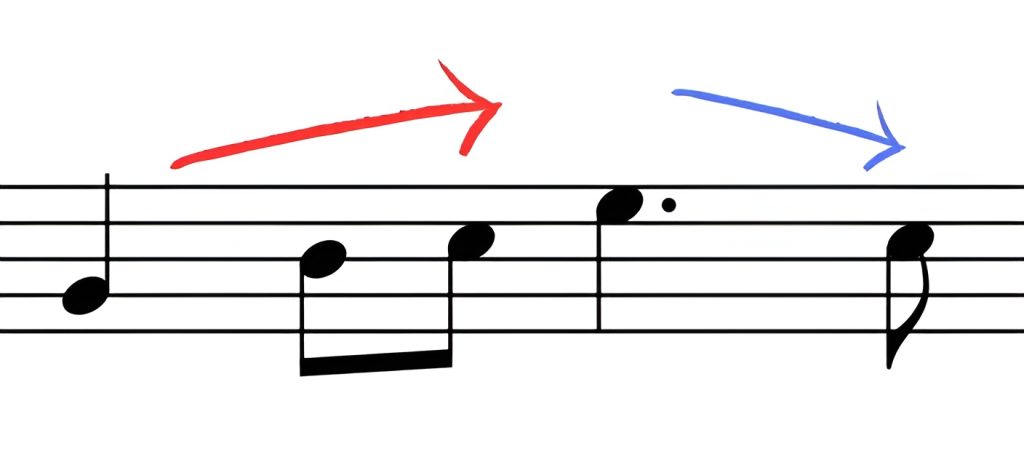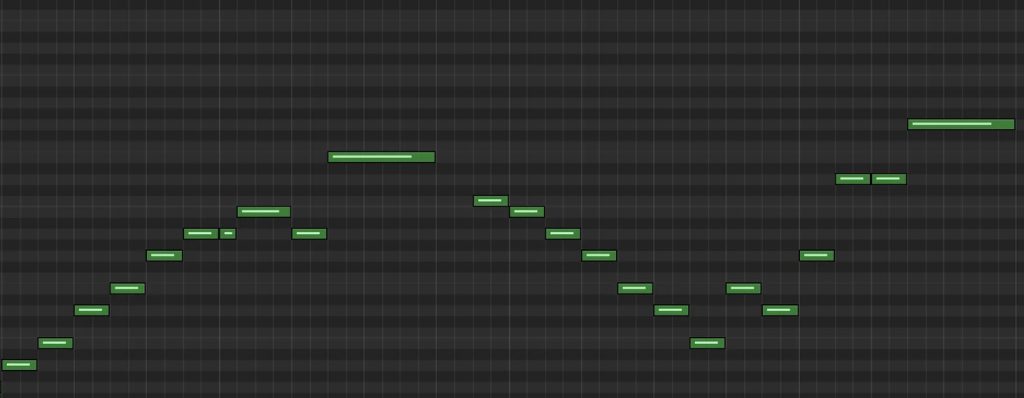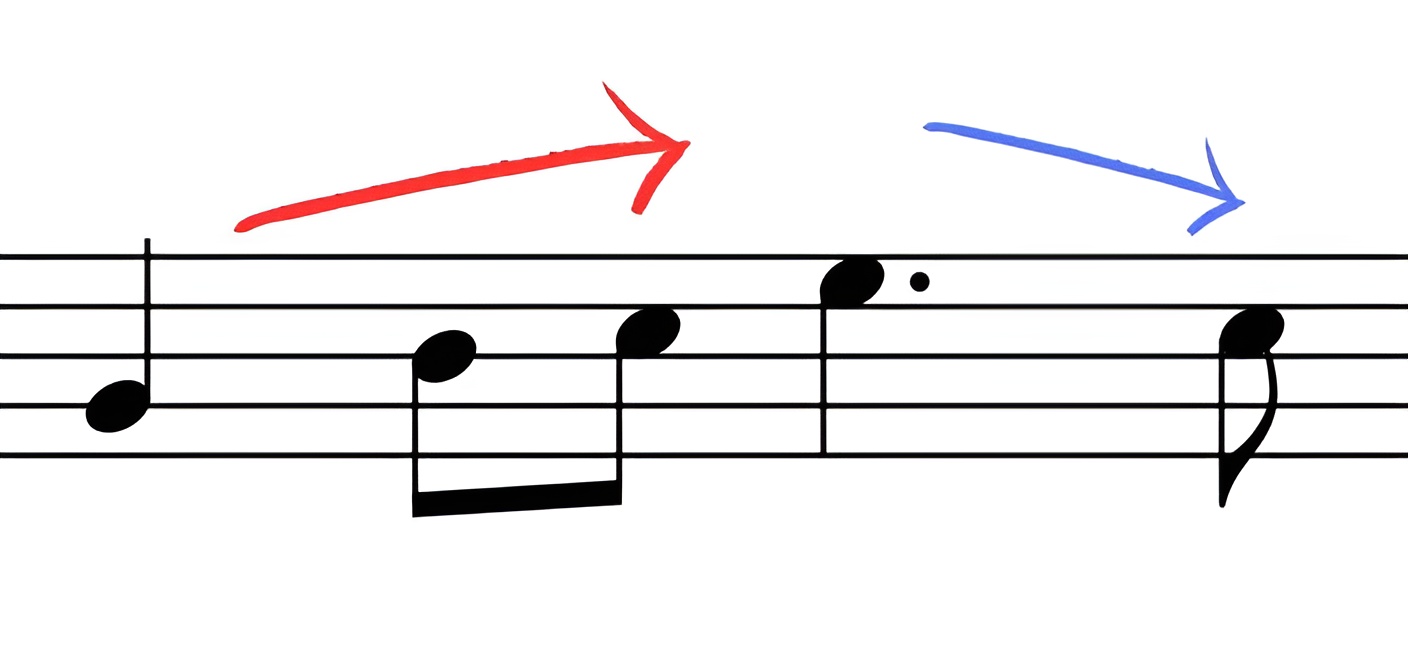When we listen to a melody, we immerse ourselves in a world of emotions and expressions that go beyond words. Melodic movement is an essential component in creating these experiences, acting as the backbone of the music and songs. We will explore its key characteristics, its influence on our perception of music and the different techniques that composers employ to give shape and direction to their melodies.

Let's go there.
The melodic movement
The first thing we must point out regarding melodies is that they happen over time and, therefore, are based on a kind of movement. Melodic movement refers to the direction and pattern in which the notes of a melody follow each other in a musical composition. In other words, it's the way individual notes connect and progress throughout the melody. Melodic movement is a fundamental aspect in the creation of a melody, as it influences the way music develops and evolves, and how it is perceived and experienced emotionally.
Main types of melodic movement
From a very basic point of view, we could say that there are two essential and primary melodic movements: The upward: when the notes tend to rise in pitch or become increasingly higher pitched. The upward movement in a melody can convey a feeling of energy, optimism, or tension, depending on the context in which it is used. Additionally, the upward movement can raise expectations in the listener and, when properly resolved, can provide a sense of satisfaction or climax. He falling: when the notes tend to get lower or lower and lower. The downward movement in a melody can convey a feeling of relaxation, sadness, or resolution, depending on how it is used in the musical context. Descending melodies often give a sense of closure or rest, especially when they resolve to the tonic or root note of the key. He flat, static or repetition: Occurs when a note is maintained or repeated in the melody without changing pitch. Static movement can add stability and strength to a melody, and can be used to create contrasts and highlight certain aspects in music: when notes tend to repeat themselves or vary very little in pitch. But this classification falls far short of explaining the enormous variety of melodies that we can find in music and songs. If we want to be a little more precise and describe more sophisticated, more real melodic movements, or in more detail, we can find these others:
Jump movement: Occurs when the notes in a melody move at intervals greater than a whole tone or semitone. The jumps can be ascending or descending and can cover several degrees of the scale. A skip movement can add drama and energy to a melody, although excessive use of large skips can make the melody more difficult to sing or remember.
Movement by step: Occurs when the notes in a melody move at intervals of a whole tone or a semitone, either ascending or descending. The step movement is more common in Western music and is usually easier to sing and remember than the jump movement. Melodies that move largely by step tend to have a smoother, more connected flow.
oblique movement: When we find two melodies developing at the same time and one of them remains static while another voice moves by step or jump. This type of movement is more common in polyphonic music, such as in counterpoint, and can create a sense of independence and contrast between voices. As you can clearly see, although it is something that goes unnoticed by the vast majority of music and song listeners, these movements are essential in the construction of melodies and can be used in various ways to create different effects and emotions in the music. Mastering the different types of melodic movement and their proper application in a composition is essential for creating attractive, memorable and emotionally expressive melodies.
 Melody in Midi interface
Melody in Midi interface
The importance of melodic structure
Melody is a fundamental component in music, since it is the sequence of notes and sounds that give character and expressiveness to a piece of music. The melodic structure is the set of elements that make up a melody and its organization. The structure may vary depending on the musical style and genre, but in general, it is made up of a series of notes that make up a musical phrase. These phrases are combined and developed to create a coherent and emotionally expressive musical speech. In Western music, the melodic structure is often organized around tonality, which is the system of harmonic and melodic relationships established around a central note called the tonic. The tonic is the point of rest and reference for the rest of the notes and chords, and the melodic structure is built using the diatonic scale that corresponds to that tonality.
The role of musical scale and modes
Scales and modes are fundamental in creating melodies, as they provide the set of notes that will be used to build the melodic structure. A scale is a succession of notes arranged in ascending or descending order, while a mode is a scale that originates by starting on a different note from its main scale. In Western music, the most common scales are major and minor. The major scale is characterized by its happy and bright sound, while the minor scale has a more melancholic and somber tone. On the other hand, modal music uses other modes such as Doric, Phrygian, Lydian, Mixolydian, Aeolian and Locrian, each with its own characteristics and emotional colors. The choice of scale or mode in a piece of music largely determines the atmosphere and emotion conveyed by the melody. Furthermore, scales and modes also influence harmonic progressions and the formal structure of music, as they determine the notes and chords that can be used in the composition. We constantly listen to song music and instrumental compositions that play with these auditory tensions and expectations.
The function of rhythm and meter
Rhythm and meter are crucial aspects in movement and melodic development, as they provide the temporal basis and movement of the melody. In a very summary way, we can say that rhythm is the distribution of notes and rests in time, while meter is the organization of rhythm into regular patterns of accents and subdivisions. In a melody, rhythm and meter can vary from simple, regular patterns to complex combinations of accents and subdivisions. The interaction between rhythm and meter with melodic structure can create different emotional and stylistic effects, such as tension and relaxation, energy and calm, or contrast and continuity. An important aspect in melodic development is syncopation, which is the accentuation of a note on a weak beat or on an unstressed subdivision of the measure. Syncopation creates a sense of surprise, displacement, and vitality in the melody, which can increase expressiveness and interest in a composition. Furthermore, rhythmic and metric variation is an important tool for maintaining the listener's interest and shaping the melodic development in a piece of music. Variations may include modifying rhythmic patterns, using irregular rhythms, or altering meter throughout the composition. These changes can be subtle or dramatic, but in general, they contribute to enriching and diversifying the musical experience.
Conclusion
In short, melodic movement is a fundamental aspect in the construction of melodies and in the creation of emotionally expressive and memorable musical experiences. Writing songs is, to a large extent, playing this game, listening to the results and choosing based on the purpose we pursue in each composition. Understanding the different types of melodic movement allows musicians, composers and composers to explore various possibilities and structures in their works, achieving those tunes that have accompanied us through the centuries, until today. That's why we remember so many melodies easily, that's why they take us to those distant, deep and intimate places, and that's why, among other reasons, we sing them… over and over again. #mailpoet_form_3 .mailpoet_form { } #mailpoet_form_3 .mailpoet_column_with_background { padding: 10px; } #mailpoet_form_3 .mailpoet_form_column:not(:first-child) { margin-left: 20px; } #mailpoet_form_3 .mailpoet_paragraph { line-height: 20px; margin-bottom: 20px; } #mailpoet_form_3 .mailpoet_segment_label, #mailpoet_form_3 .mailpoet_text_label, #mailpoet_form_3 .mailpoet_textarea_label, #mailpoet_form_3 .mailpoet_select_label, #mailpoet_form_3 .mailpoet_radio_label, #mailpoet_form_3 .mailpoet_checkbox_label, 3 .mailpoet_list_label, #mailpoet_form_3 .mailpoet_date_label { display: block; font-weight: normal; } #mailpoet_form_3 .mailpoet_text, #mailpoet_form_3 .mailpoet_textarea, #mailpoet_form_3 .mailpoet_select, #mailpoet_form_3 .mailpoet_date_month, #mailpoet_form_3 .mailpoet_date_day, #mailpoet_form_3 .mailpoet_date_year, #mailpoet_form_3 .mailpoet_date { display :block; } #mailpoet_form_3 .mailpoet_text, #mailpoet_form_3 .mailpoet_textarea { width: 200px; } #mailpoet_form_3 .mailpoet_checkbox { } #mailpoet_form_3 .mailpoet_submit { } #mailpoet_form_3 .mailpoet_divider { } #mailpoet_form_3 .mailpoet_message { } #mailpoet_form_3 .mailpoet_form_loading { width: 30px; text-align: center; line-height: normal; } #mailpoet_form_3 .mailpoet_form_loading > span { width: 5px; height: 5px; background-color: #5b5b5b; }#mailpoet_form_3{border: 1px solid #fcb900;border-radius: 40px;text-align: center;}#mailpoet_form_3 form.mailpoet_form {padding: 20px;}#mailpoet_form_3{width: 70%;}#mailpoet_form_3 .mailpoet_message {margin : 0; padding: 0 20px;}#mailpoet_form_3 .mailpoet_paragraph.last {margin-bottom: 0} @media (max-width: 500px) {#mailpoet_form_3 {background-image: none;}} @media (min-width: 500px) { #mailpoet_form_3 .last .mailpoet_paragraph:last-child {margin-bottom: 0}} @media (max-width: 500px) {#mailpoet_form_3 .mailpoet_form_column:last-child .mailpoet_paragraph:last-child {margin-bottom: 0}} Please leave this field emptyDo you write songs or would you like to?
Email * I have read and accept the Privacy Policy With the Guide «The journey of a song» as a gift Check your inbox or spam folder to confirm your subscription.

